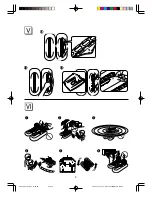
ENG
8
SEALED NiCd (NICKEL-CADMIUM)
BATTERY.
‑
IF THE HOVERCRAFT, BATTERY AND
TRANSMITTER ARE WET, THOR-
OUGHLY DRY BEFORE USING OR
CHARGING.
- REGULARLY EXAMINE ALL WIRES AND
CONNECTORS. IN THE EVENT OF
DAMAGE, DO NOT USE.
The hovercraft is powered by Nickel-Cad-
mium technology, and requires no special pro-
cedures or precautions for disposal. However,
as with all products, you should dispose of
your NiCd battery in an environmentally re-
sponsible and considerate manner.
Important:
- If driving time becomes shorter or
propellers does not turn with full power,
the capacity of the 9V battery or 9.6V
battery pack are insufficient. (Power LED
light becomes dimmer as batteries wear.)
It is the tale-tell sign you need to replace
the 9V battery or recharge the 9.6V
battery pack.
- Be sure to recharge the hovercraft just
before driving it. If you do not play with the
hovercraft immediately after recharging,
the charge is drained and the hovercraft
cannot drive.
- When the battery temperature gets too
high, the circuit shuts off automatically to
protect the receiver circuit and the battery
in the hovercraft. In such a case, wait until
the battery cools down before recharging
or playing with the hovercraft.
- If the rechargeable battery is repeatedly
charged without being sufficiently
discharged first, the capacity will gradually
decrease (memory effect of battery). This
is a characteristic of rechargeable
batteries. Be sure to start recharging after
operating the propellers until they nearly
stop.
VII. SAFETY INFORMATION
Adults, this toy is recommended for children
8 years of age and older. To ensure that the
child's play is both safe and fun, please re-
view the operating instructions and these
general safety rules with the child.
- Keep fingers, hair and loose clothing away
from the propellers while the hovercraft is
switched ON.
- Adult supervision is recommended when
the hovercraft is being operated.
- To avoid accidental operation, remove the
removable battery when not in use.
- If the hovercraft and/or transmitter get
wet, discontinue use until they are
completely dry.
Thoroughly wipe off all moisture and allow
them to air-dry completely before use.
- DO NOT drive in the street! Make sure
you have plenty of open space in all
directions (please see Section VI).
- Regularly inspect the antenna for cracks
or breaks. Do NOT bend the transmitter
antenna. DO NOT use the transmitter if
the antenna is broken.
- The hovercraft 's wire antenna is fragile.
Never pull or tug on the antenna, as it may
loosen or detach from the hovercraft.
Never coil or knot the antenna.
NOTE: The manufacturer is not responsible for
any radio or TV interference caused by
unauthorized modifications to this equipment.
Such modifications could void the user's
authority to operate the equipment.
TROUBLESHOOTING GUIDE
When vehicle does not float
Make sure the vehicle power is on.
Make sure the main battery and the
transmitter battery have sufficient
charge.
Make sure the skirt is correctly in-
serted.
Check if the skirt is broken.
Check the skirt for punctures due
to rocks or broken pavement.
When vehicle does not move or moves
slowly
Check if any unauthorized batter-
ies are used.
Make sure the main battery and the
transmitter battery have sufficient
charge.
Check if the distance between the
transmitter and the vehicle exceeds
30m.
Drive on a surface with high fric-
tion resistance, such as sands,
grass, or carpet.
When vehicle is not operational
Make sure the vehicle power is on.
Make sure the main battery and the
transmitter battery have sufficient
charge.
Check if the main battery and the
transmitter battery are inserted with
correct polarity.
Check if the distance between the
transmitter and the vehicle exceeds
30m.
Check if a near transmitter pro-
duces interference or signals with
the same frequency. In such a
case, move to another place or try
after a while.



























